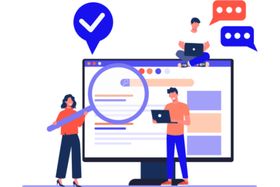Secrets to Shopify Retention: Top Tips to Maximize Customer Loyalty
Investing in Shopify retention can be a complete game changed for your eCommerce. Here's what you need to know about this.
Published January 31, 2025

The average retention rate for Shopify customers is around 28% -- not an amazing number, but definitely one that can be improved if you use the right tactics.
We asked our Shopify experts to tell us more about what works in Shopify retention in 2025, and their answers have been quite revealing. Keep reading if you want to get more bang for your buck through customer loyalty.
Customer retention, defined
When aiming for success on Shopify, many entrepreneurs focus heavily on acquiring new customers. While new customers are essential for growth, focusing on customer retention is equally, if not more, important. Customer retention refers to the strategies and efforts businesses use to keep their existing customers coming back for repeat purchases.
Retaining customers is crucial because it is far more cost-effective than acquiring new ones. Studies have shown that acquiring a new customer can cost five times more than retaining an existing one. Additionally, loyal customers tend to spend more over time, making them incredibly valuable for long-term growth. In this article, we’ll explore why customer retention is key, how to measure it, and the best strategies you can implement to improve your Shopify store's retention rate this year.
(Source)
Why should you focus on your Shopify retention in 2025?
Customer retention is a pivotal metric for any Shopify store, as it directly impacts profitability and growth. Here are a few reasons why you should make customer retention a priority this year:
Increased customer lifetime value: Retained customers are likely to make repeat purchases, increasing their lifetime value to your business. This means higher revenue per customer over time.
Better ROI: Retaining customers is more cost-effective than acquiring new ones. It allows you to maximize the return on your initial customer acquisition efforts.
Stronger brand loyalty: Happy, loyal customers often become brand ambassadors, recommending your store to others and helping you grow through word-of-mouth.
Competitive advantage: In a crowded e-commerce landscape, a loyal customer base can give you an edge over competitors.
Time and again, research has shown that retaining customers can be a much more business-savvy strategy than focusing solely on acquiring them. In fact, sometimes, acquiring new customers can be up to five times more expensive than retaining them -- and it makes sense. Every new customer acquisition comes with a cost, which is almost entirely eliminated when you retain a current customer.
How to calculate your Shopify customer retention rate
Knowing your customer retention rate is essential for tracking how effectively your business is retaining customers over time. To calculate your retention rate, use the following formula:
Customer Retention Rate = ((Number of customers at the end of a period - New customers acquired during the period) ÷ Number of customers at the start of the period) x 100
For example, if you had 1,000 customers at the start of the year, gained 200 new customers, and ended the year with 1,100 customers, your retention rate would be:
((1,100 - 200) ÷ 1,000) x 100 = 90%
This percentage represents the portion of your customer base that stayed with you over the given period. A high retention rate signals strong customer loyalty, while a low rate may indicate a need to reevaluate your customer experience and marketing strategies.
How to measure customer retention
Measuring customer retention requires tracking more than just the actual customer retention rate, but also additional key metrics that provide insights into customer behavior and loyalty. Here are some of the most important metrics to focus on:
Repeat customer rate
The repeat customer rate measures the percentage of customers who make more than one purchase. To calculate this, divide the number of returning customers by the total number of customers and multiply by 100. For example, if 200 out of your 1,000 customers are repeat buyers, your repeat customer rate is 20%. A high repeat rate indicates strong customer loyalty.
Purchase frequency
Purchase frequency tracks how often customers make purchases within a given time frame. To calculate purchase frequency, divide the total number of orders by the number of unique customers. For instance, if your store has 500 orders and 200 customers, your purchase frequency is 2.5. This metric helps you understand how often customers are coming back to shop.
Average order value
Average order value (AOV) measures the average amount spent per order. To calculate AOV, divide your total revenue by the total number of orders. For example, if your revenue is $50,000 and you had 1,000 orders, your AOV is $50. Increasing your AOV can significantly boost your overall revenue.
Customer lifetime value
Customer lifetime value (CLV) estimates the total revenue a customer is expected to generate during their relationship with your business. To calculate CLV, multiply the average order value by purchase frequency and then by the average customer lifespan. For instance, if your AOV is $50, purchase frequency is 3, and customer lifespan is 2 years, your CLV would be $300.
Churn rate
Churn rate measures the percentage of customers who stop purchasing from you over a specified period. To calculate churn rate, divide the number of customers lost by the total number of customers at the start of the period, then multiply by 100. A high churn rate indicates that you might need to work on improving customer satisfaction and loyalty.
The best customer retention strategies to implement this year
Improving customer retention requires a combination of strategies aimed at enhancing the customer experience and building loyalty. Here are some of the most effective strategies to implement:
Encourage customers to create accounts
By encouraging customers to create accounts, you make it easier for them to shop with you again. Accounts allow customers to save their information, track orders, and receive personalized recommendations. To encourage sign-ups, make the process quick and straightforward, and highlight the benefits of creating an account.
Keep in mind people are not easy to share their email addresses (particularly with growing privacy concerns). Therefore, consider offering incentives such as discount codes or free shipping when creating an account.
Double down on quality customer support
Providing excellent customer support is one of the most effective ways to retain customers. Customers value quick, helpful responses to their questions and issues. Invest in a strong support team, offer multiple communication channels (like live chat and email), and aim to resolve issues promptly.
Some of the most important tips to keep in mind when improving your customer care include the following:
Ensure responses are timely and well-informed
Train support staff to handle a variety of customer inquiries
Use a friendly and empathetic tone in communications
Provide an easily accessible FAQ or help center
Regularly gather and implement customer feedback
Utilize technology to streamline support services
Offer 24/7 assistance if possible to meet customer expectations
Work on your customer loyalty programs
Loyalty programs reward customers for their repeat business, incentivizing them to come back. Offer points for purchases, referrals, or social media shares, and let customers redeem those points for discounts or free products. A well-designed loyalty program can significantly boost retention.
Some examples of successful loyalty programs include Starbucks' rewards program, Sephora's Beauty Insider program, and Amazon Prime's membership program. All of these programs know exactly how to serve their customers and make them want to come back for more.
Offer discounts for return buyers
Provide special discounts or promotions for returning customers to encourage repeat purchases. For example, offer a "welcome back" discount code or exclusive deals for loyal customers. These little incentives can go a long way in building customer loyalty.
Ask for feedback and listen
Regularly ask customers for feedback on their experience with your store. Use surveys, email requests, or social media polls to gather insights. Most importantly, act on the feedback you receive to improve your offerings and show customers that their opinions matter.
You may find many customers are reluctant to provide feedback, so it's essential to make the process as easy and convenient as possible. Consider offering an incentive or entering customers into a giveaway for completing a survey.
Amp up your email marketing
Email marketing is a powerful tool for keeping your customers engaged. Send personalized emails with product recommendations, exclusive deals, and updates. Use email automation to reach out to customers who haven’t shopped in a while or to thank them for their loyalty.
To make your email campaigns even more effective, focus on creating eye-catching subject lines that encourage customers to open your messages. Segment your audience based on their preferences, purchase history, or browsing behavior to ensure your content is relevant and timely. Including visuals, clear calls-to-action, and mobile-friendly designs can also boost engagement and drive conversions. When done right, email marketing not only strengthens customer relationships but also helps increase sales and brand loyalty.
Make returns easy… really easy
A hassle-free return policy can make a big difference in retaining customers. Make the process simple, transparent, and customer-friendly. When customers know they can return an item without stress, they’re more likely to shop with you again.
Build a subscription service
Subscription services provide a steady revenue stream and keep customers coming back regularly. If your products are consumable or need replenishment, consider offering a subscription option with discounts or perks for subscribers.
Offer rewards for referrals
Encourage your customers to refer their friends and family to your store by offering rewards. For example, give both the referrer and the referred customer a discount or free product. Referral programs are a great way to attract new customers while keeping your current ones engaged.
Make it a game for your customers
Gamification adds a fun, interactive element to the shopping experience. Introduce challenges, rewards, or achievements customers can unlock by making purchases or engaging with your brand. Gamification can help create a sense of excitement and loyalty among your customers.
Examples of brands that successfully use gamification to engage customers include Myntra, an Indian fashion eCommerce platform, which gamified its app during the End of Reason Sale campaign in 2023. Users could play games to earn points and rewards, significantly boosting brand awareness and sales. This interactive approach not only increased customer engagement but also fostered a sense of community among users, leading to higher retention rates
Provide education and connection
Offer educational content, such as blog posts, tutorials, or webinars, that helps customers get more value from your products. Building a community around your brand through forums or social media groups also fosters connection and loyalty.
Implement buy now, pay later solutions
Offering flexible payment options like buy now, pay later (BNPL) can make your store more appealing to customers. BNPL allows customers to split their payments over time, making it easier for them to purchase higher-value items without hesitation.
Keep pricing competitive
Competitive pricing is essential for retaining customers, especially in a market where comparison shopping is easy. Regularly review your pricing to ensure it aligns with industry standards while still delivering value to your customers.
Be genuine, authentic, and trustworthy
Customers value authenticity and transparency.
Of course, this comes without saying, but be honest about your products, pricing, and policies, and focus on building trust with your audience. Genuine connections with customers create long-lasting loyalty.
Personalize your marketing communications
Personalization is key to making customers feel valued. Use data to tailor your marketing messages, product recommendations, and promotions to individual preferences. Personalized experiences can significantly improve customer satisfaction and retention.
2025 is the time for retention
Your Shopify store could be doing so much better if you focused on customer retention -- in fact, this is one fo the surefire ways to grow your business in 2025. As competition intensifies, retaining existing customers becomes more critical than ever.
If you need help with that, don't hesitate to contact Mayple and we'll match you with the best Shopify experts and agencies for your specific industry and needs. Start working with the best of the best in less than 72 hours (and stay assured the entire process is fully managed for you too.)






![How to Find the Top Ecommerce Marketing Agency + 10 Questions to Ask [{year}]](https://entail.mayple.com/en-assets/mayple/fit-in/280x280/61c08d1ce64c590dd1c738bd_threewomensittinginanoffice_b9153095395125eb258609c660b08dfc_2000-1699776097553.jpg)
![Ecommerce SMS Marketing: Killer Strategies & Tools [{year}]](https://entail.mayple.com/en-assets/mayple/fit-in/280x280/61d2eaecc0646c4d836b0902_TextmessagesSMS_9e858991f96ea29248bd1ee2fda38b6a_2000-1699776075122.jpg)